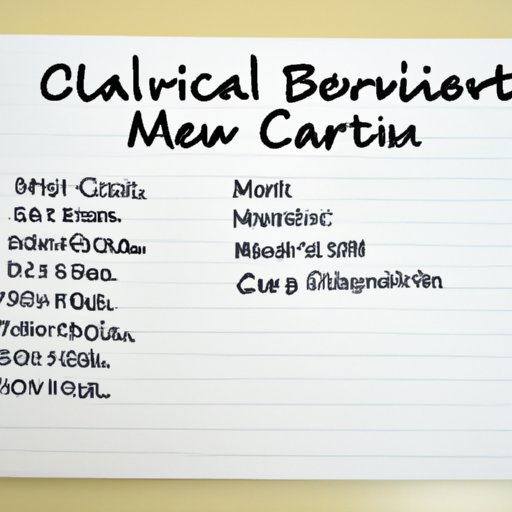Introduction
Losing weight can be a challenge, but one of the most important concepts to understand when trying to slim down is the concept of a calorie deficit. A calorie deficit occurs when you burn more calories than you consume. To lose weight, you must create and maintain a calorie deficit over time. In this article, we’ll explore how much of a calorie deficit is necessary to lose weight and provide tips on how to achieve it.
Calculating Your Calorie Deficit: How to Determine the Right Amount to Lose Weight
The first step in creating a calorie deficit is to calculate your Basal Metabolic Rate (BMR). Your BMR is the amount of energy your body needs to perform basic functions such as breathing, circulating blood, and digesting food. It is the number of calories your body needs just to exist. Knowing your BMR will help you determine how many calories you should eat each day to achieve a calorie deficit.
Once you have calculated your BMR, you can set your calorie goal. The amount of calories you need to consume to create a calorie deficit depends on your activity level. Generally, you should aim to reduce your calorie intake by 500-750 calories per day to see results. If you are very active, you may want to reduce your intake by up to 1000 calories per day.

Eating Strategies to Reach a Calorie Deficit and Lose Weight
Creating a calorie deficit doesn’t mean you have to starve yourself. There are several strategies you can use to make sure you are meeting your calorie goal while still eating healthy. First and foremost, you should track your calorie intake. Counting calories is an effective way to ensure you are staying within your target range. Secondly, you should try to eat frequently throughout the day. Eating smaller meals throughout the day helps keep your energy levels up and prevents overeating during meals.
Finally, it’s important to make healthy choices when choosing what to eat. Eating nutrient-dense foods such as fruits, vegetables, lean proteins, and whole grains can help you feel fuller longer and prevent cravings. Avoid processed foods as they tend to be high in calories and low in nutrients.
Understanding the Science Behind Calculating a Calorie Deficit for Weight Loss
In order to understand how to use a calorie deficit to lose weight, it’s important to understand how the body uses calories. Calories are made up of three primary macronutrients: protein, carbohydrates, and fat. Each macronutrient has its own unique benefits for the body. Protein helps build muscle, carbohydrates provide energy, and fats are essential for hormone production and cell growth.
When calculating a calorie deficit, it’s important to make sure you are consuming enough of each macronutrient to meet your body’s needs. Generally, a healthy diet should consist of 40-50% carbohydrates, 25-30% protein, and 20-30% fat. However, depending on your activity level and health goals, these ratios may vary.

Meal Planning Tips for Reaching a Calorie Deficit
Meal planning is an important part of reaching a calorie deficit. When planning your meals, it’s important to plan ahead. Make sure you have all the ingredients you need for the week so that you don’t end up grabbing unhealthy options at the last minute. Additionally, limit refined sugars and incorporate superfoods into your diet. Superfoods are nutrient-dense foods that are packed with vitamins and minerals.

The Benefits of a Calorie Deficit for Weight Loss
Creating a calorie deficit has several health benefits beyond weight loss. When you create a calorie deficit, your metabolism increases, which means your body is able to burn more calories even when you’re not exercising. Additionally, because you’re eating fewer calories, you’ll have more energy throughout the day. Finally, maintaining a calorie deficit reduces your risk of developing chronic diseases like diabetes and heart disease.

Exercising for a Calorie Deficit: What You Need to Know
Exercise is an important part of creating a calorie deficit. There are several types of exercise you can do to help you reach your goals. Cardio exercises such as running, biking, and swimming are great for burning calories. Strength training is also important for building muscle and increasing your metabolism. The key is to find activities that you enjoy and that fit into your lifestyle.
It’s also important to remember that diet and exercise go hand in hand when it comes to achieving a calorie deficit. Both are equally important for reaching your goals. Combining a healthy diet with regular exercise will help you create a calorie deficit and see results faster.
Popular Diets and Their Impact on Achieving a Calorie Deficit
There are several popular diets that focus on creating a calorie deficit. Low-carb diets, such as the ketogenic diet, are designed to restrict carbohydrates and increase fat and protein intake. Low-fat diets, on the other hand, restrict fat intake and focus on eating mostly carbohydrates and proteins. Intermittent fasting is another popular diet that involves alternating periods of eating and fasting. All of these diets can help create a calorie deficit, but it’s important to choose one that fits your lifestyle and health goals.
Conclusion
Achieving a calorie deficit is essential for successful weight loss. Knowing how to calculate and maintain a calorie deficit can help you reach your health goals faster. By understanding the science behind calories and eating strategies, you can create a calorie deficit that works for you. Additionally, combining a healthy diet with regular exercise will help you achieve lasting results.


